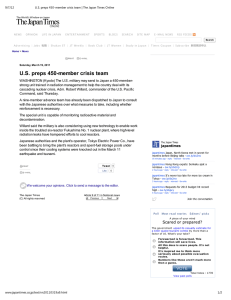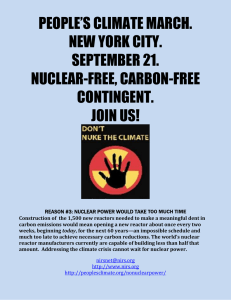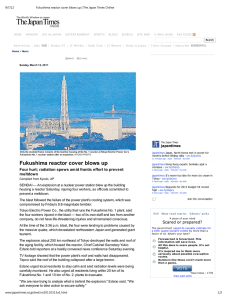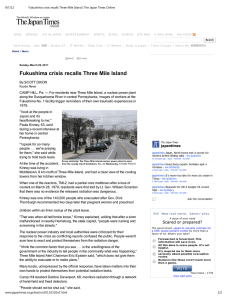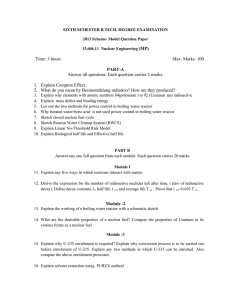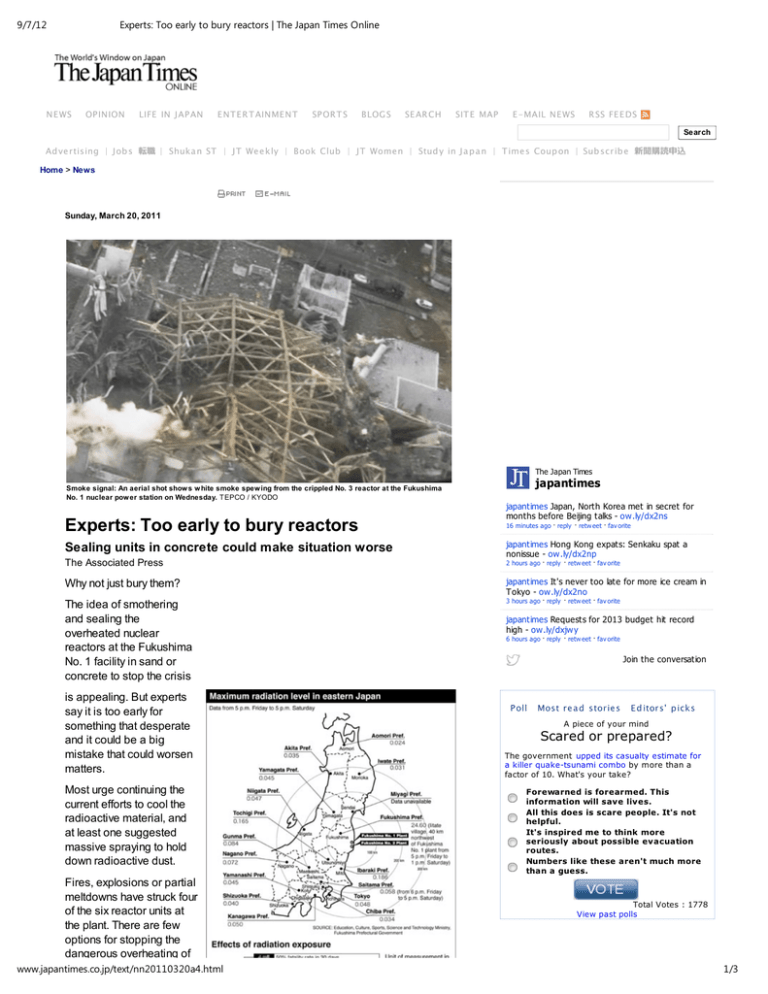
9/7/12
Experts: Too early to bury reactors | The Japan Times Online
NE WS
OP INION
LIFE IN J AP AN
E NT E R T AINME NT
SP OR T S
BLOG S
SE AR CH
SIT E MAP
E -MAIL NE WS
R SS FE E DS
Search
Ad ve rtising | J ob s 転職 | Shuka n ST | J T We e kly | Book Club | J T Wome n | Stud y in J a p a n | T ime s Coup on | Sub scrib e 新聞購読申込
Home > News
Sunday, March 20, 2011
The Japan Times
Smoke signal: An aerial shot show s w hite smoke spew ing from the crippled No. 3 reactor at the Fukushima
No. 1 nuclear pow er station on Wednesday. TEPCO / KYODO
Experts: Too early to bury reactors
Sealing units in concrete could make situation worse
The Associated Press
japantimes
japantimes Japan, North Korea met in secret for
months before Beijing talks - ow.ly/dx2ns
16 minutes ago · reply · retw eet · fav orite
japantimes Hong Kong expats: Senkaku spat a
nonissue - ow.ly/dx2np
2 hours ago · reply · retw eet · fav orite
Why not just bury them?
japantimes It's never too late for more ice cream in
Tokyo - ow.ly/dx2no
The idea of smothering
and sealing the
overheated nuclear
reactors at the Fukushima
No. 1 facility in sand or
concrete to stop the crisis
3 hours ago · reply · retw eet · fav orite
is appealing. But experts
say it is too early for
something that desperate
and it could be a big
mistake that could worsen
matters.
Most urge continuing the
current efforts to cool the
radioactive material, and
at least one suggested
massive spraying to hold
down radioactive dust.
Fires, explosions or partial
meltdowns have struck four
of the six reactor units at
the plant. There are few
options for stopping the
dangerous overheating of
www.japantimes.co.jp/text/nn20110320a4.html
japantimes Requests for 2013 budget hit record
high - ow.ly/dxjwy
6 hours ago · reply · retw eet · fav orite
Join the conversation
P oll
Most re a d storie s
E d itors' p icks
A piece of your mind
Scared or prepared?
The government upped its casualty estimate for
a killer quake-tsunami combo by more than a
factor of 10. What's your take?
Forewarned is forearmed. This
information will save lives.
All this does is scare people. It's not
helpful.
It's inspired me to think more
seriously about possible evacuation
routes.
Numbers like these aren't much more
than a guess.
Total Votes : 1778
View past polls
1/3
9/7/12
Experts: Too early to bury reactors | The Japan Times Online
dangerous overheating of
nuclear materials.
Firetrucks sprayed tons of
water Friday, and workers
hope to restart cooling
systems once a new
power line is installed.
Reporters raised the
notion Friday of sealing the
reactors and fuel rods in
concrete as an emergency Click graphic to enlarge.
measure. But officials with
the Nuclear and Industrial Safety Agency and the plant's operator, Tokyo Electric
Power Co., didn't embrace the idea.
"We believe it is not a realistic option," said Hidehiko Nishiyama of the nuclear
agency. And Teruaki Kobayashi, a Tepco manager, said the utility wouldn't rule
out entombing the reactors but thinks the probability is low.
It's true that concrete tombs may someday stand at the troubled nuclear
complex, one expert said, but only as a long-term strategy once the radiation
has cooled.
The entombment idea has been touted on American television by Michio Kaku,
a physics professor at City College of New York and a television host on the
Science Channel. He has talked about dumping a combination of boric acid to
dampen the nuclear fission, sand and eventually concrete to seal off the nuclear
material.
Such a massive effort would take days if not weeks to plan, so he argues
preparation should start now in case it becomes necessary. He envisioned an
armada of helicopters and workers to dump sand and then concrete to smother
the spent-fuel pool and other damaged nuclear material.
But experts see risk. For one thing, the structures that confine the radioactivity
now could be damaged if heavy loads of material are dumped on them, opening
new avenues for the hazard to escape.
"When you drop tons of material from hundreds of feet in a helicopter, you're
going to do some damage," said Alex Sich, a nuclear engineer at Franciscan
University in Ohio. "It could be a bad idea. . . . I would ask them to stop and think
three times before they do any dumping of heavy materials."
Sich, who has lived in Chernobyl and published research on the disaster there,
noted that Russian authorities dumped some 5,000 tons of sand, clay and other
materials from helicopters in an attempt to smother that dangerous reactor.
The Fukushima situation is different, he said. The reactors are surrounded by
multiple barriers designed to contain radiation from the reactor cores. If a heavy
dumping cracked the inner vessels and exposed the reactor cores, "that would
be absurdity," he said.
Other risks focus on the spent fuel rods, which are a key source of alarm. While
pouring tons of sand on the rods would block radiation from escaping, it would
also insulate them and make them heat up faster. The heat could decompose
the concrete floor, allowing the rods to fall through, which could complicate
efforts to contain the radiation, said Elmer Lewis of Northwestern University.
Sich suggested it might be better to spray the reactor with dust-suppressing
materials from helicopters, as was done at Chernobyl. Dust is one way for
radioactivity to spread great distances.
Maybe sprayers could be installed to continuously tamp down dust, he said,
while acknowledging the installation would further expose workers to radiation.
Lewis, who has consulted frequently on reactor issues for U.S. national labs,
said the time for concrete tombs might come once the radioactive materials
have cooled — a process that could take years.
Tw eet
www.japantimes.co.jp/text/nn20110320a4.html
0
2/3
9/7/12
Experts: Too early to bury reactors | The Japan Times Online
Tw eet
Like
0
0
We welcome your opinions. Click to send a message to the editor.
The Japan Times
(C) All rights reserved
Article 4 of 10 in National news
About us | Work for us | Contact us | Privacy policy | Link policy | Registration FAQ
Advertise in japantimes.co.jp.
This site has been optimized for modern browsers. Please make sure that Javascript is enabled in your browser's preferences.
The Japan Times Ltd. All rights reserved.
www.japantimes.co.jp/text/nn20110320a4.html
3/3

